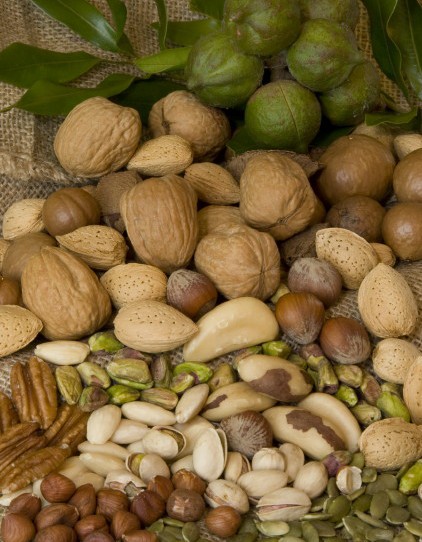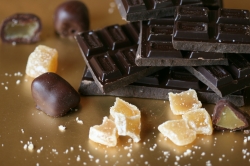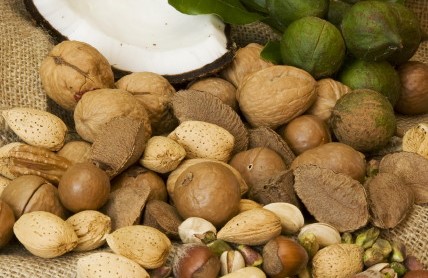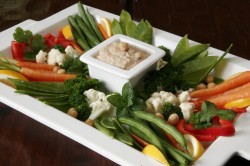Stone-Fruit Season: Just Peachy
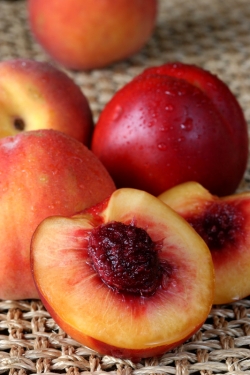
Historical Background
Botanical Plant Facts
Phytochemicals
Nutritional Facts
Dried Fruits
Shopping Tips
Pesticide Residue and cleaning tips
References
“Mon ami, an apple is an excellent thing – until you have tried a peach.”
With the thoughts of French writer George du Maurier (1834-1896), we continue our series, “The Sweet Secrets of Fruit.” In this installment, we would like to introduce you to the nutritional characteristics of peaches (Prunus Persica var. Persica) as well as to its botanical relatives nectarines (Prunus Persica var. Nectarina) and apricots(Prunus Armeniaca).
After a summer of indulging in tasty berries, it is now time to enjoy juicy, mouth-watering and unbelievably sweet peaches, nectarines and apricots. They are packed with phytochemicals, vitamins and minerals. Because a vitamin or mineral deficiency can cause health problems, their intake is absolutely vital for our health and essential for our body to function. Phytochemicals, on the other hand, are not essential or nutrients, but their intake has been strongly linked to a reduced risk of major chronic diseases.
In addition, our aim is to address the issue of pesticides in conventionally and organically grown produce in more detail. We would like to give you ideas on how to clean fruits and vegetables to make them as residue-free as possible in order to help you enjoy clean, healthy, quality produce.
Besides health-benefiting aspects, we were inspired for this article by the world’s largest 10K, the Peachtree Road Race. Its venue is Atlanta, Georgia, also known as the Peach State. This race has helped make peaches a familiar fruit to runners from all over the world, including Uta and KIMbia’s runners, who have had great success there over the years.
Historical Background
Peaches, nectarines and apricots traveled through the ages and over the continents before they enjoyed such widespread popularity as they do today. The peach is now the third most popular fruit grown in the United States, but did you know that it originated in China? Below, we will explore the journey this tree-fruit took from ancient China to us today.
Peaches were actively cultivated in Western China and Tibet 4,000 years ago. Ancient Chinese medicine men saw peaches as a symbol of long life and immortality. Chinese merchants used the legendary silk-trading routes to export early versions of today’s peach to Persia (now Iran). Around 400 to 300 B.C. the Greek and Roman empires spread peaches over Europe. Later, throughout the 16th and 17th centuries, peaches crossed the Atlantic Ocean with the Spanish and Portuguese explorers, who brought them to America. The settlers and Native Americans incorporated peaches into their diets, and spread its cultivation further. Interestingly, peaches still have a special place in Chinese culture, as they are a traditional birthday gift.
The history and origin of the nectarine has not been determined with certainty. Some believe that it is a variety of the peach, without the fuzz. The same uncertainty applies to the origin of the fruit’s name. In 1616, the word “nectarine” was first used in England. It has been suggested that the name is derived from the Greek word “nekter,” which is the drink of the gods in Greek and Roman mythology. But, there is no conclusive evidence.
Apricots have their origin in China as well. The discovery of their wild forms dates back almost 4,000 years, when they were found in the mountain slopes of China. Ancient Chinese doctors thought they may enhance fertility in woman. Via the silk-trading routes, Chinese merchants brought apricots to Persia, and their spread around the world began. Alexander the Great brought them to the Mediterranean areas. Following this, around 100 B.C., the Romans started cultivating apricots. Fun fact: The Greeks called apricots “the golden eggs of sun.”
Botanical Plant Facts
Before we talk in detail about the phytochemicals, vitamins and minerals contained in peaches, nectarines and apricots, let us discuss their botanical characteristics.
All three fruits belong to the plant family Prunoideae, which is a subfamily of the Rosaceae, or the rose family. Botanically, they are drupes or stone fruits. Members of the Prunoideae family can mostly be found in moderate climates; only a few are found in tropical areas. Besides peaches, nectarines and apricots, plums, cherries and almonds belong to the Prunoideae family as well. They are tree-fruits. During the spring, you can see their trees blossoming with the most gorgeous and colorful flowers.
Phytochemicals
Despite the uncertainty about the historical relationship between nectarines and peaches, one thing is certain—they have identical phenolic profiles(1). This means they possess the same active compounds that have so many health benefits.
Peaches, nectarines and apricots all contain small concentrations of members of the phenolic subclass flavonoids, such as anthocyanin, quercetin and kaempferol(2). Flavonoids(3) are associated with fantastic characteristics such as preventing cardiovascular and neurodegenerative diseases as well as cancer. They achieve this with the help of their antioxidative properties. Antioxidants protect our body from so-called free radicals by scavenging them. Free radicals are constantly formed in the body as a result of dealing with the environment, lifestyle choices and as a side effect of our metabolism. Their levels increase when: air pollution gets worse; we make bad drinking water and food choices; we use certain cleaning products, paints and cosmetics; and other factors, such as ultraviolet radiation, smoking, alcohol abuse or mental stress. For more information on free radicals look out for one of our future nutrition articles.
Even better, peaches also are rich in wonderful substances called phytosterols; in particular stigmasterols(4), which make up about 5% of all phytosterols. They act by reducing the intestinal absorption of cholesterol. Also, phytosterols, especially stigmasterols, inhibit enzymes that are active within the internal cholesterol production, meaning that they can reduce the body’s own cholesterol production. High levels of the low-density cholesterol LDL are strongly associated with a higher risk for developing cardiovascular diseases(5). Phytosterols have been found to lower the total cholesterol and the LDL cholesterol without affecting the HDL cholesterol and therefore may prevent the associated diseases.
Nutritional Facts
In addition to being rich in phytochemicals, stone fruits are low in calories and a great source of vitamins and minerals, as you can see in the table below(6). The values given are for single medium-sized fruits:
| Nutritional Values | Peach | Nectarine | Apricot |
|---|---|---|---|
| Calories | 59 kcal | 62 kcal | 17 kcal |
| Carbohydrates | 14 g | 15 g | 4 g |
| Dietary Fiber | 2 g | 2 g | 1 g |
| Protein | 1 g | 2 g | 0 g |
| Fat | <1 g | 0 g | 0 g |
| Water | 133 g | 124 g | 30,2 g |
| Main Vitamins | C, A, E, Niacin & K | C, A, Niacin, E & K | A & C (excellent source) |
| Main Minerals | Potassium, Copper & Manganese | Potassium, Copper, Manganese & Phosphorus | Potassium, Copper & Manganese |
Peaches, nectarines, and especially apricots are high in vitamin C and A. A medium apricot contains on average 674 IU (international units) of vitamin A and 3.5 mg. of vitamin C. The Recommended Daily Allowances (RDA) for vitamin A range from 2,310 (women) to 3,000 (men) IU; for vitamin C, from 65 (women) to 75 (men) mg. You can cover your daily needs for vitamin A with 4 to 5 apricots, and meet 20% of your vitamin C need as well.
Food is the best source for nutrients, dietary fibers and phytochemicals. A balanced diet with lots of fruits and vegetables should provide them sufficiently. The combination of compounds naturally occurring in foods may provide synergistic or additive effects. This means the individual compounds work together. As a result more health beneficial effects can be achieved in comparison to single compounds found in supplements.
Imagine nutritional components as little pieces of a big network. Every piece has its part and function. When pieces are missing the network will still function somewhat, but it will never reach its full potential. Your health is determined by your own complex dietary habits and not by an individual factor. But, supplements used right can act as safety net. In times of higher needs for nutrients, such as when under stress and during illnesses or when food simply does not provide enough, it can be very beneficial to take supplements.
Research has focused for many years on isolated food compounds. An endless number of studies have concentrated on the effects of vitamin A or C, and others, by themselves. Now, research has started to take a new approach, and the concept of synergy has shifted into the center of attention. With this focus not only a better understanding of health-promoting properties will be achieved, but also the foundation for more effective and safer supplements may be laid.
Dried Fruits
Fresh peaches and apricots are a sweet and healthy delicacy, but you can enjoy them dried as well. In their dried form they are an excellent source of dietary fiber, minerals and vitamins, as shown in the table below(4). The values given are for a cup of dried fruit:
| Nutritional Values | Dried Peach | Dried Apricot |
| Calories | 382 kcal | 313 kcal |
| Carbohydrates | 98 g | 81 g |
| Dietary Fiber | 13 g | 9 g |
| Protein | 6 g | 4 g |
| Fat | 1 g | 1 g |
| Water | 50,9 g | 40,2 g |
| Main Vitamins | A, Niacin, K, Riboflavin, C & Pantothenic Acid | A, E & Niacin |
| Main Minerals | Potassium, Iron, Copper, Manganese & Magnesium | Potassium, Copper, Iron Manganese & Magnesium |
Dried fruits are an excellent high-fiber snack. Dietary fiber plays a major role in our intestinal health. Although it is indigestible for the body, its passage through the body has many advantages. It softens the stool and lowers the risk for developing hemorrhoids, irritable bowel syndrome and diverticular disease. Also, it decreases serum total and LDL cholesterol levels. Another great dietary aspect of fiber is its ability to prolong the feeling of being full. Therefore, it can help to control body weight. Additionally, there are advantages for people with diabetes due to its ability to delay the absorption of sugar. Blood glucose levels may be lowered after a meal. Last but not least, it speeds up bowel transit time and helps you to stay regular.
Dried fruits can be enjoyed on their own, mixed with nuts and seeds, or in snack bars that contain them. Including dried fruits in your muesli or oatmeal will add exciting flavors. Regardless of how you include dried fruits in your diet, you will benefit from their health-promoting properties.
Research has shown another great characteristic of dried fruits, here exemplified by apricots. The antioxidant concentration of one dried fruit doesn’t differ much from the concentration of its fresh form. One way to measure this is the FRAP-Test (ferric-reducing ability of plasma). The table below gives an overview of the measured antioxidant concentration in medium-sized fresh and dried apricots.
Total antioxidants in fresh and dried apricots
(adapted from Halvorsen et al(7) for a 35g fresh apricot and an 8g dried apricot):
| Apricot | Overall Mean Concentration (mmol/fruit) |
| fresh | 0,18 |
| dried | 0,26 |
In grocery stores you will find two kinds of dried fruits – sulfured and unsulfured. Stick to the unsulfured ones. Sulfating substances are used to preserve dried apricots and peaches as well as other dried fruits and can cause allergies. Sulfite sensitivity shows up in many ways, including dermatological, pulmonary, gastrointestinal and cardiovascular symptoms. It has also been reported to trigger asthma.
Moreover, dried fruits are a great snack readily available in grocery stores. They are a nutritious option for you and your children, especially in the winter, when fresh local produce is limited.
Shopping Tips
Peaches, nectarines and apricots grow and ripen during the early and midsummer months. Fruits purchased at farmers’ markets or local stands tend to be fairly ripe. In larger stores they tend to be less ripe to protect the fragile flesh of these fruits. If they are not completely ripe, don’t refrigerate them; let them ripen in a dark place and then refrigerate them. Otherwise, they will get a mealy texture and won’t taste as good.
When choosing these fruits at the grocery store, smell them; they should have a pleasing aroma. Even though colors might vary, a red color with a yellow background is the sign of a ripe peach or nectarine. Upon pressure they should not feel too hard or too soft. Do not choose fruits that have soft spots or bruises.
They will last five to seven days in the refrigerator, but they will taste best when stored at room temperature.
As always, choose local produce when possible, to support local business and to save natural resources needed for long transportation routes.
Pesticide Residues on Produce
Unfortunately, peaches and nectarines are among the fruits with high amounts of pesticide residues, as you can see in the table below (adapted from a publication by the Environmental Working Group(8)). Therefore, we want to show you what you can do to enjoy these wonderful and delicious fruits without worrying about pesticides and other contaminants.
| Rank | Produce | Percentage of Produce with detected pesticides | Average number of different pesticides found | Max. number of pesticides found on a produce item |
| 1 | Peaches | 96.6 % | 3.1 | 9 |
| 2 | Apples | 93.6 % | 2.8 | 9 |
| 3 | Sweet Bell Peppers | 81.5 % | 2.4 | 11 |
| 4 | Celery | 94.1 % | 3.0 | 9 |
| 5 | Nectarines | 97.3 % | 3.0 | 7 |
| 6 | Strawberries | 92.3 % | 2.3 | 8 |
| 7 | Cherries | 91.4 % | 2.8 | 7 |
| 8 | Lettuce | 68.2 % | 1.7 | 9 |
| 9 | Imported Grapes | 84.2 % | 1.8 | 8 |
| 10 | Pears | 86.2 % | 1.6 | 6 |
As you can see, the peach is number one on the list. This is a concern, because the pesticides are on the peel(9), and at the same time the majority of the phytochemicals and nutrients are located in the peel. The problem that comes with pesticides is their carcinogenic and mutagenic potential, and the fact that long-term exposure may be harmful to the kidneys or liver. Clearly, you want to minimize the amounts of man-made, potentially dangerous, chemicals you take in with your daily diet.
That does not mean you have to reduce or avoid these produce items. It matters what kind of produce you buy, and it makes a difference how you clean it before consumption.
The first step to better produce is taken by choosing organic items. This will exclude the majority of pesticides from your diet. Conventional produce is up to six times more likely to contain several pesticide residues than organic produce(10).
However, there might be limited access to organic produce depending on where you live. Or it does not fit your budget, due to its sometimes higher price. If that is the case, you should focus even more on the cleaning process, which is the second step to better produce.
For cleaning, plain water is not good enough. It will remove dirt, but not pesticides that do not dissolve in plain water or the waxes that make the fruits so shiny. Instead, use warm water with a little dish soap added to it or so-called fruit and vegetable washes. The latter mostly can be found in the bigger grocery stores in the produce section. Two common brands are Veggie Wash and Fit Fruit and Vegetable Wash, with a price of approximately $4. Being especially designed for cleaning fruits, they are all-natural, leave no aftertaste and rinse off easily.
In my opinion, treating produce with ozone is the best cleaning option. Ozone, or triplet oxygen (O3), is a highly reactive gas, and a powerful oxidizing agent commonly used to sterilize drinking water. It functions as a germicide(11, 12), which means it destroys algae, viruses, bacteria and fungi on contact. Its major benefit in relation to pesticides is its ability to oxidize and, as a result, break down harmful chemicals into simpler, less hazardous molecules. Afterward, the ozone decomposes in a short time and leaves no toxic residues(12).
There are several devices on the market that you can use to ozonate produce. We have great experiences with the Lotus Sanitizing System from Tersano. Here, the food is treated with ozone while being surrounded by water. This procedure is FDA-approved since 2001. The costs for the appliance vary, but the average price is about $150. We think this product is easy to use and also works well for other food items such as poultry and seafood.
To conclude, after pre-washing your fruits and vegetables, ozonate them. This will give you the cleanest, most healthful possible produce.
(1) Tomás-Barberán FA, Gil MI, Cremin P, Waterhouse AL, Hess-Pierce B and Kader AA: HPLC-DAD-ESIMS Analysis of Phenolic Compounds in Nectarines, Peaches and Plums. Journal of Agricultural and Food Chemistry 2001;48:4748-4760.
(2) Ruiz D, Egea J, Gil MI and Tomás-Barberán FA: Characterization and Quantitation of Phenolic Compounds in New Apricot (Prunus armeniacaL.) Varieties. Journal of Agricultural and Food Chemistry 2005,53:9544-9552.
(3) Manach C, Scalbert A, M Christine, Rémésy C and Jiménez L: Polyphenols: food sources and bioavailability. American Journal of Clinical Nutrition 2004;79(5)727-747.
(4) Fernándes C, Suárez Y, Ferruelo AJ, Gómes-Coronado D and Lasunción MA:Inhibition of cholesterol biosynthesis by unsaturated phytosterols via competitive inhibition of sterol reductase in mammalian cells. Biochemical Journal 2002;366:109-119.
(5) American Heart Association: About Cholesterol: Good vs. Bad Cholesterol. www.Heart.org, retrieved March 2012.
(6) NutritionData – Nutrition Facts and Calorie Counter: Peaches, Nectarines and Apricots. www.nutritiondata.com, retrieved July 2007.
(7) Halvorsen BL, Holte K, Myhrstad MCW, Barikmo I, Hvattum E, Remberg SF, Wold AB, Haffner K, Baugerød, Anderson LF, Moskaug JØ, Jacobs DR and Blomhoff R: A Systematic Screening of Total Antioxidants in Dietary Plants. http://jn.nutrition.org/cgi/content/full/132/3/461, The Journal of Nutrition 2002;132:461-471.
(8) Environmental Working Group: Shoppers Guide to Pesticides in Produce. www.ewg.org/foodnews, retrieved August 2007.
(9) MI, Tomás-Barberán FA, Hess-Pierce B and Kader AA: Antioxidant Capacities, Phenolic Compounds, Carotenoids, and Vitamin C Contents of Nectarine, Peach, and Plum Cultivars from California. Journal of Agricultural and Food Chemistry 2002;50:4976-4982.
(10) Burros M: Study Finds Far Less Pesticide Residue on Organic Produce.The New York Times, retrieved August 2007.
(11) University of Wisconsin: Chemical of the week. www.scifun.org/CHEMWEEK/Ozone/ozone.html, retrieved May 2007.
(12) Liu Z., R. Ruan, Y. Li, P. Chen, and T. Krick: Ozone treatment to reduce or remove pesticides in fruits and vegetables. 2003 IFT Annual Meeting, Chicago, Illinois , July 12-16.
- Posted September 7, 2007
© 2007-2025 Janett Walter and Take The Magic Step®
